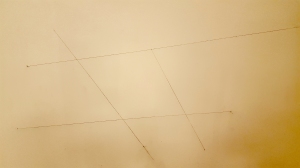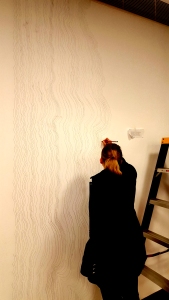As part of my Bachelor of Digital Media, I am required to do assessments. One such of these tasks me with exploring the way translation and transmission effects a technology. My chosen technology is the Printing Press. Let’s begin.
Circa 1440, the printing press is invented by Johannes Gensfleisch zur Laden zum Gutenberg, a smith from Germany who later became a printer and publisher after his invention. A Christian Bible, printed in Latin, was the first text to be mass produced by Gutenberg’s machine. Prior to this, printing was done through manual work of carving, engraving and wood block printing, or through hand writing. Gutenberg’s machine vastly sped up this process, allowing for a rapid expansion in the availability of books and other text based media. This, in general, is praised as one of the greatest inventions of all time. Francis Bacon listed the printing press as one of the top three inventions that had changed the world. In Francis Bacon’s Instauratio Magna (1620) he lists the printing press as one of the most influential inventions in the world. It is the parent technology to technologies so commonly used today, such as inkjet printing and xerography.
At the time, however, it had a very drastic effect on the culture of the time. Of the printing press, Marshal Mcluhan said “The invention of typography confirmed and extended the new visual stress of applied knowledge, providing the first uniformly repeatable commodity, the first assembly line, and the first mass production” (1962, p. 124). McLuham identified that the printing press had some questionable social impacts. For example, it led to the rise of the nation state, where countries were recognised as political powers and the government having a sovereignty over the people. It also assisted in the establishment of colonisation and empires, which involved these sovereign nations expanding and conquering. The ability to mass produce documents means that information is much easier to spread and thus much easier to come by. This ease of access allowed the property owning upper class to further excel themselves by creating contracts and bills for their tenants, as well as further their own education and distance themselves intellectually from those socially and economically bellow them.
However, simply producing the exact same documentation does not insure that the same message is transmitted. As nations expanded and languages clashed, the need for translations and translators skyrocketed. A Latin Bible was no longer enough for people. Having a taste of how much easier mass production made spreading works, the people desired to have their own copies of writings. Gone were the days when only the priest would read the Bible and it was his interpretation that was law. The printing press allowed for personal copies, in a language that was common for the people, and with this, personal interpretations of what a writing meant. It is this personal interpretation and idea of recreation that American conceptual artist Solomon “Sol” LeWitt taps into in his works.
LeWitt is well known, not for his creation of artworks, but more for his instruction of artworks. His works consist of a set of well thought out instructions that are given to the producers of the artworks. There are some with very rigorous steps to produce a very controlled result:
A quadrangle which is formed and enclosed by four lines, the first of which is drawn from a point halfway between a point halfway between the center of the wall and the upper left corner and the midpoint of the left side and the upper left corner to a point halfway between the midpoint of the top side and the upper right corner, the second line from a point halfway between the start of the first line and a point halfway between the midpoint of the top side and the upper left corner to a point halfway between a point halfway between the center of the wall and the lower left corner and the mid- point of the bottom side, the third line from a point halfway between a point halfway between the start of the first line and the end of the second line and a point halfway between the midpoint of the left side and the lower left corner to a point which is on an axis between the lower left corner to a point halfway between the midpoint of the right side and the upper right corner where a line drawn from the center of the wall to a point halfway between the midpoint of the right side and the lower right corner would cross that axis, the fourth line from a point equidistant from the end of the third line, the end of the second line and a point halfway between a point halfway between the center of the wall and the midpoint of the bottom side and a point halfway between the midpoint of the bottom side and the lower right corner to a point halfway between the start of the second line and a point where a line would cross the first line if it were drawn from the midpoint of the right side to a point halfway between the midpoint of the top side and the upper left corner.
And some with more open instructions, allowing for interpretation.
The first drafter draws a not straight vertical line as long as possible. The second drafter draws a line next to the first one, trying to copy it. The third drafter does the same, as do as many drafters as possible. Then the first drafter followed by the others, copies the last line drawn until both ends of the wall are reached.
Both of these allow for individual interpretation or translation. The first, however, has many stipulations and very precise directions to lower the room for error. In one sense, it has a well levelled signal : noise ratio.
It is in these ways that the limitations of translation and transmission can be lessened. By reducing the number of steps, the transmission is easier, but the translation can be more open. By including more instructions, the translation is less likely to be misinterpreted, but the transmission will take more time. It is very important to get this ratio correct.
All in all, the invention of the Printing Press had a drastic impact on the social, cultural and political landscape of the day. It lead to a boom in mass production, growth of nations and empires and is the precursor to a number of still commonly used technologies today. The expansion and availability of literature, coupled with the interpretive nature of reading led can be seen as a link to Sol LeWitt’s works, and helps to highlight issues and limitations in translation.
References:
Bacon, F, 1620, Novum Organum Scientiarum, London, Independently Published.
McLuhan, M, 1962, The Gutenberg Galaxy: The Making of the Typographic Man, 1st ed, Canada, University of Toronto Press.
LeWitt, S, 1974, Wall Drawings, Pencil, varying sizes, varying locations.
Deleflie, E, 2015, Technological Determinism, lecture notes distributed in Computational Media 102 at University of Wollongong, Wollongong on 6 August 2015.

